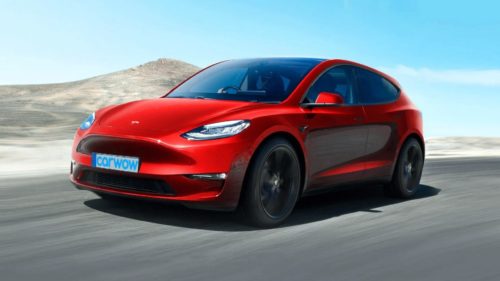Tesla’s “Investor Day” disappointed many people, even tanking Tesla stock for a day, as there were no major announcements, including their new, affordable, next-generation automobile, as was anticipated. The majority of the information you need to know about the automobile, aside from when you can purchase it, was already disclosed by them.
Model 2 is probably not Tesla’s name. Although others have claimed the name “Model E,” the Model 3 should have been the Model E to spell out “SEXY.”
(Read this story as the original article with photo and junk-ads here.)
It won’t exceed the list price of $30,000
A Model 3 used to theoretically be available for $35,000, but today’s entry-level vehicle costs $43,000. According to Tesla, after tax credits and gas savings, this is “actually” roughly $29,000 in California. Savings on maintenance are not included in that.
People already think a Model 3 is less expensive to buy than a Corolla, yet it has a larger initial investment and lower ongoing expenses.
We can see from the figure that Tesla has stated they anticipate the total cost of ownership over the first 60,000 miles (5 years) will be exactly 71% of the Model 3’s. This includes roughly $2,000 in electricity costs as well as very little maintenance, such as 1.5 to 2 sets of tires at $800 each and a few other extremely small things. Although the smaller model might be a little lighter and utilize less expensive tires, they shouldn’t differ significantly between the two cars. Registration fees, insurance, and most importantly depreciation, will be the other big expenses.
Today, Tesla is not adopting the methods of important websites like Edmunds and Kelly Blue Book in order to have the Model 3 beat the Corolla. According to Tesla’s 2021 Impact Report, the cost is roughly 63 cents/mile. You’ll see that compared to gasoline-powered vehicles, the depreciation rate for the Tesla accounts for a far higher percentage of the overall cost. The key strategy for decreasing TCO is to lower sticker prices. Below is a breakdown of Tesla’s 2021 plans for the Model 3 from the Impact report.
This report, however, is for the Model 3 at a comparable cost and excludes the $7500 federal tax credit. (At the time the study was published, the cost in 2021 was between $39K and $43K.) Some insurance elements do change depending on the car’s worth. Hence, although we can’t be precise because different cars may depreciate at different rates, we can conclude that around 66% of the TCO after rebates is based on the cost of the car.
Since the after-credit price will be 60.5% of the Model 3 after-credit price for TCO to fall to 71%, the car’s sticker price should be around $29,000, which is slightly more than the $25K price that is typically indicated. (Update: This post had previously calculated the cost using a different method at roughly $26,000, but the $29K number is likely closer to the truth given the impact of credits. If Tesla has employed state credits in its computation this would modify it further.)
Of fact, after subtracting $7,500 in federal credits and state credits ($2,000 in California and up to $5,000 in Colorado), the price for a new Tesla economy model in Colorado would be $16,700 plus fees at the door. a model that will also save you 50% on operating costs. It’s difficult to imagine any entry-level car buyer who is cost concerned choosing a car at today’s gasoline costs.
In spite of Tesla’s prediction that the Model 3 would cost $35,000, the company only briefly sold the vehicle at that price. (It’s also possible that Tesla made the graphic above so that the new model received all of the incentives and the Model 3 received none, but that would be odd.) So, it’s probable that their above chart’s cost prediction won’t come true. Therefore, anything at this price range will be revolutionary.
How excellent is the car?
That must be terrible at this price, right? After all, the standard Chevy Bolt is below this pricing range, but doesn’t compare to a Model 3, which considerably outsells it even at a much higher price. The new vehicle may not have the 270-mile range of a Model 3, but it most likely will come close since it uses LFP batteries, which have a very long life and make it easier to use all of the available range. You should attempt to only sometimes charge the car up to 100% with the Lithium Nickel batteries found in higher end automobiles, however you can do it if you need to. The additional range may not matter as much in this class of car because there are quick chargers every 50 miles on major roads and at home.
Tesla stressed their production ethos—make it cheaper and better at the same time—during the entire presentation. They haven’t always followed through on that; for instance, when they removed ultrasonic sensors to save money, parking assist was also deleted, although they promise it will come back soon.
Tesla’s entire focus is on turning the automobile into a computer. The more a car is a computer, the more its economics are based on electronics, which means it will get better and cheaper at the same time, and not just a little bit cheaper, but much cheaper.
This Silicon Valley way of thinking is also being used by Tesla in its manufacturing and design, and it appears to be working.
Also seen at the top is their estimate that they can produce the full powertrain for this car for about $1,000. They might be able to produce special needs cars for substantially less than $29,000 at that cost + battery pack.
We may anticipate that Tesla’s updated model won’t be significantly worse than the original Model 3, and that the Model 3 will likely improve to justify its higher price. Certain items will become slightly more affordable, especially those that Tesla does not produce, including the upholstery, paint, tires, and perhaps sound deadening. Although you won’t expect it to, the inside won’t seem luxurious. As needed by physics, the shape will remain essentially the same. If two-motor 4WD is not an option, the front motor’s room will compensate for the Model 3’s storage advantage.
You’ll have a comparable screen, possibly a little smaller, and a comparable uncluttered dashboard. In general, they favor everything that can be controlled by software and is well-made, albeit they may eliminate additional physical buttons and the passenger seat’s motorized seat adjustments. You most likely won’t get a gearbox stalk because they previously removed them from high-end vehicles. To keep the initial price low, they might not include the same hardware pack, or HW4, that they think will be required for FSD. Instead, they might remove some of the cameras and leave room to update them later.
The software will include a lot of posh features. Software takes money to write even though it is free to copy. With its more expensive vehicles, Tesla intends to make money by providing you fancier software rather than richer hardware.
These days, you can pay $500 or $2500 for various laptops and $200 or $1,000 for various phones. The capabilities of those gadgets don’t differ by a factor of five; in many circumstances, the less expensive device can perform tasks that the more expensive one cannot. Tesla will also do it in its autos. Consider Apple, which raises the price of similar hardware by creating more desirable software than its competitors.
No matter which Tesla model you choose, you will benefit from the vastly superior charging network, which is now one of the main incentives to do so.
The van, what about it?
The distribution of the world’s automobile fleet, as represented by Tesla’s vehicle categories
TESLA
Here, Tesla informs us that they anticipate there to be 700 million vehicles worldwide (not just Teslas) in the new platform car class, in addition to 380 million higher priced sedans and 40 million luxury sedans. Also, they predicted 300M units of the category of “working” vehicles, which included vans and pickup trucks like the CyberTruck. Therefore it appears that a van is in the future.
Will this be a minivan for families or a business van for work and deliveries? Perhaps, as they’ve suggested, a van-style taxi for their designated robotaxi? They omitted saying that. But, that comes after the base-model Tesla.
Pre-ordering is not yet possible. But, we are aware of its price, a general idea of its appearance, and a list of its features. The Y also revealed that it would be produced in a brand-new facility in Mexico, however this won’t have a significant impact on the final product if you decide to purchase it.

